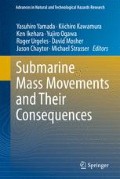Abstract
The relationship between slip behavior and fault-rock properties has been investigated from several perspectives, including rock mechanics, landsliding, and earthquake faulting. This includes mainly studies on land, but recently also from submarine settings, since increasing availably of new offshore technologies allow marine fault/slip zone drilling and monitoring. Here we present a detail study for a subaerial landslide in SW Japan, the conceptual and methodological approach of which may provide important means towards better understanding various friction behaviors including ocean margin slope creeping and submarine landslides.
Thousand of landslides occur in the Japanese mountains during precipitation events, and monitoring systems have been installed for disaster management and mitigation. Slopes in many of these areas undergo repeated continuous stable creep and episodic acceleration without catastrophic failure. We monitored the dynamic processes of pore-fluid-induced episodic landslides during two typhoons associated with heavy rain in the 300 m × 800 m Utsugi landslide area in the Jurassic Chichibu complex. A basal fault defining the landslide body has a maximum depth of approximately 30 m and is exposed at the surface at the top and bottom ends. Borehole pipes that penetrate the basal fault have been installed at 13 sites for monitoring tilt and groundwater levels. We used five of these sites for dynamic monitoring. In two cases, slip initiation occurred in the area where the groundwater level rose quickly during the rainfall. We analyzed the fault rocks at this site in a drill core obtained during the dry season and in another drill core obtained immediately after a slip event. The fracture zone at the slip depth is overlaid with low permeable gouge, inferred to have developed by shear grind. In the post-slip event core, the fracture zone has much higher water content than that in the dry season core. The gouge layer and fracture zone may thus act as an impervious cap rock and a conduit for fluid, respectively. The fault rock and fluid flow system likely developed over a long period, and thus can explain the repeated initiation of slip at the same location.
Access this chapter
Tax calculation will be finalised at checkout
Purchases are for personal use only
References
Aki K (1979) Characterization of barriers on an earthquake fault. J Geophys Res 84:6140–6148
Anderson SH, Gantzer CJ, Boone JM, Tully RJ (1988) Rapid nondestructive bulk density and soil-water content determination by computed tomography. Soil Sci Soc Am J 52:35–40
Byrne T, Maltman A, Stephenson E, Soh W, Knipe R (1993) Deformation structures and fluid flow in the toe region of the Nankai accretionary prism. Proc ODP Sci Results 131:83–101
Lay T, Kanamori H (1981) An asperity model of great earthquake sequences. In: Simpson D, Richards P (eds) Earthquake prediction: an international review, Maurice Ewing series. AGU, Washington, DC, pp 579–592
Lei X (2003) How do asperities fracture? An experimental study of unbroken asperities. Earth Planet Sci Lett 213:347–359
Marone C, Scholz CH (1989) Particle-size distribution and microstructures within simulated fault gouge. J Struct Geol 11:799–814
Ohnaka M, Shen L (2003) Scaling of the shear rupture process from nucleation to dynamic propagation: implication of geometric irregularity of the rupturing surfaces. J Geophys Res 104:817–844
Sammis C, Osborne R, Anderson JL, Banerdt M, White P (1986) Self-similar cataclasis in the formation of fault gouge. Pageoph 124:53–78
Soh W, Byrne T, Taira A, Kono A (1993) Computed tomography (CT) scan image analysis of Site 808 cores: structural and physical property implications. Proc ODP Sci Result 131:135–140
Stegmann S, Sultan N, Kopf A, Apprioual R, Pelleau P (2011) Hydrogeology and its effect on slope stability slong the coastal aquifer of Nice, Franc. Mar Geol 280:168–181
Suemine A (1983) Observational study on landslide mechanism in the area of crystalline schist (Part 1) an example of propagation of Rankine state. Bull Disaster Prev Inst Kyoto Univ 33:105–127
Sultan N, Savoye B, Jouet G, Leynaud D, Cochonat P, Henry P, Stegmann S, Kopf A (2010) Invesitgation of a possible submarine landslide at the Var delta frong (Nice-slope – SE France). Can Geotech J 47:486–496
Turcotte DL (1986) A fractal model for crustal deformation. Tectonophysics 132:261–269
Ujiie K, Maltman AJ, Sanchez-Gomez M (2004) Origin of deformation bands in argillaceous sediments at the toe of the Nankai accretionary prism, southwest Japan. J Struct Geol 26:221–231
Acknowledgments
This research was supported in part by a grant from the Japan Society for the Promotion of Science, no. 15340173. We used the landslide disaster monitoring system in the Utsugi area of Kochi Prefecture. X-ray CT analyses were performed at the Center for Advanced Marine Core Research, Kochi University. We are grateful to the students at Kochi University who helped with the monitoring. Thanks are also due to Dr. Hiroshi Kameya of Oyo Corporation, as well as to reviewers K. Kawabata, O. Fabbri and associate editor M. Strasser for helpful suggestions.
Author information
Authors and Affiliations
Corresponding author
Editor information
Editors and Affiliations
Rights and permissions
Copyright information
© 2012 Springer Science+Business Media B.V.
About this paper
Cite this paper
Sakaguchi, A. et al. (2012). Spatially Fixed Initial Break Point and Fault-Rock Development in a Landslide Area. In: Yamada, Y., et al. Submarine Mass Movements and Their Consequences. Advances in Natural and Technological Hazards Research, vol 31. Springer, Dordrecht. https://doi.org/10.1007/978-94-007-2162-3_7
Download citation
DOI: https://doi.org/10.1007/978-94-007-2162-3_7
Published:
Publisher Name: Springer, Dordrecht
Print ISBN: 978-94-007-2161-6
Online ISBN: 978-94-007-2162-3
eBook Packages: Earth and Environmental ScienceEarth and Environmental Science (R0)

